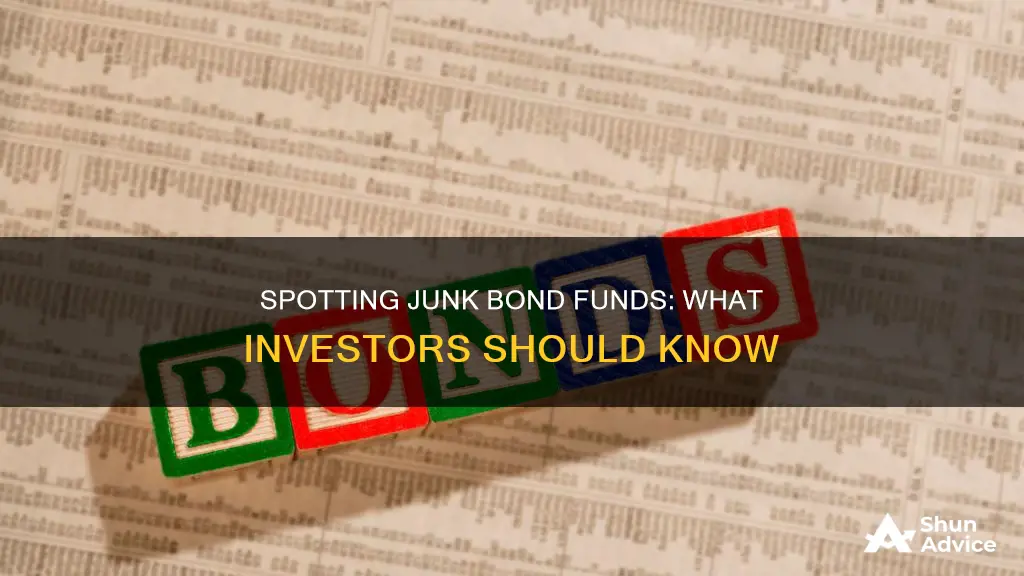
Junk bonds, also known as high-yield bonds, are bonds that carry a higher risk of default than most bonds issued by corporations and governments. They are issued by companies that are financially struggling and have a high risk of defaulting on interest payments or repaying the principal to investors. Junk bonds are generally rated BB or lower by Standard & Poor's and Ba or lower by Moody's. These lower-rated bonds pay a higher yield to investors to compensate for the greater risk. Investors can buy junk bonds individually through a broker or invest in a junk bond fund managed by a professional portfolio manager. When deciding whether to invest in junk bonds, it is important to consider the higher risk and potential for default, as well as the higher interest rates and potential for diversification that they offer.
Characteristics of Junk Bonds
| Characteristics | Values |
|---|---|
| Type of Bond | Corporate and government bonds |
| Risk | High risk |
| Rating | Below investment grade |
| Default Risk | Higher than investment-grade bonds |
| Interest Rate | Higher than investment-grade bonds |
| Issuers | Capital-intensive companies with high debt ratios or young companies |
| Performance | Outperformed Treasury bonds |
| Buyers | Institutional investors |
What You'll Learn

Junk bonds are high-risk, high-yield investments
Junk bonds are a type of high-yield corporate bond that are rated below investment grade. They are issued by companies with poor credit quality and carry a high risk of default. As a result, junk bonds are considered riskier than other bonds. The risk of default is higher because companies that issue junk bonds are typically start-ups or companies that are financially struggling.
Junk bonds are also known as high-yield bonds because they offer higher interest rates than investment-grade bonds. The higher yield is needed to help offset the risk of default. Issuers of junk bonds tend to be start-up companies or capital-intensive firms with high debt ratios. However, some junk bonds are issued by companies that were once rated as investment grade but have since been downgraded due to concerns about their financial health.
Although junk bonds are considered risky investments, investors can monitor the level of risk by reviewing the bond's credit rating. Credit rating agencies such as Standard & Poor's and Moody's rate bonds based on the financial ability of the issuer to repay the debt. Bonds with a rating of BB or lower by S&P or Ba and lower by Moody's are considered junk bonds.
Despite the risks, junk bonds can be attractive to investors because of the potential for higher returns. Junk bonds can also serve as a market-risk indicator, as increased buying interest in junk bonds indicates that investors are willing to take on more risk due to a perceived improving economy.
For investors interested in junk bonds, investing in a high-yield bond fund can be a good option. These funds are managed by professional money managers and can help to diversify an investor's portfolio. However, it's important to note that junk bonds have much larger price swings than higher-quality bonds, and there is a higher risk of losing your investment.
Investing in Mutual Funds for Minors: A Step-by-Step Guide
You may want to see also

They are issued by companies with poor credit ratings
Junk bonds are issued by companies with poor credit ratings. These companies are often financially struggling and have a high risk of defaulting on their debt or interest payments. They may also be unable to buy back the bond at maturity.
Credit rating agencies such as Standard & Poor's, Moody's and Fitch assess the creditworthiness of bond issuers and assign letter grades to indicate the risk of default. Bonds with a rating of BBB or higher are considered "investment-grade", while those with a rating below BBB/Baa are considered "speculative-grade" or "junk bonds".
Junk bonds are typically issued by companies with a high debt ratio or young companies that have yet to establish a strong credit rating. They may also be issued by companies that have faced recent financial difficulties or are in a period of poor performance.
The quality of junk bonds can vary. While some are issued by companies in mediocre or poor financial shape, others may be issued by companies in reasonably good financial health.
Junk bonds are riskier than investment-grade bonds, and as such, they offer higher interest rates to attract investors.
Why Investment Funds Need Broker-Dealers: A Strategic Partnership
You may want to see also

They are also known as speculative-grade bonds
Junk bonds are also known as speculative-grade bonds. They are given this name because they are rated below investment grade by the big three rating agencies: Moody's, Standard & Poor's, and Fitch.
Junk bonds are issued by companies that are financially struggling and have a high risk of defaulting on their debt. The risk of default is reflected in the low credit rating given to these bonds. A credit rating is an assessment of the creditworthiness of a bond issuer and its ability to meet its financial obligations. The lower the credit rating, the higher the risk of default.
Junk bonds are considered speculative because there is a significant chance that the issuer will default on the debt. This means that investors in junk bonds may not receive the interest payments or the return of their principal investment. As such, junk bonds are riskier investments compared to investment-grade bonds.
Despite the higher risk, junk bonds offer higher yields or returns to compensate investors for taking on additional risk. The higher yield is needed to offset the risk of default.
Explore Mutual Funds for Your Defence Sector Investment
You may want to see also

Junk bond funds are a safer way to invest
Junk bonds are a type of high-yield corporate bond that is rated below investment grade. They are issued by companies or governments that are financially struggling and carry a higher risk of defaulting than most bonds. Due to this higher risk, junk bonds offer higher yields or interest rates to investors.
Additionally, junk bond funds offer a low investment minimum, ranging from a few hundred to a few thousand dollars, allowing investors to gain exposure to a range of bonds. However, it is important to note that junk bond funds usually include higher management fees and commissions, and there may be a redemption fee if shares are sold within 60 to 90 days.
When considering investing in junk bond funds, it is crucial to understand the risks involved. These funds can be more volatile due to the higher default risk of the underlying junk bonds. Investors should carefully assess the fund's holdings, fees, and overall risk profile before making any investment decisions.
Overall, while junk bond funds carry higher risks, they can provide a safer way to invest in junk bonds compared to picking individual bonds. The diversification and professional management offered by these funds can help mitigate some of the risks associated with this asset class.
A Guide to Mutual Fund Investing: Getting Started
You may want to see also

Junk bonds are rated by Standard & Poor, Moody's or Fitch
Junk bonds are a type of high-yield corporate bond that are rated below investment grade. They are issued by companies that are financially struggling and have a high risk of defaulting on interest payments or the repayment of the principal to investors. Because of the higher risk, investors are compensated with higher interest rates.
Junk bonds are rated by credit rating agencies such as Standard & Poor's, Moody's, and Fitch. These agencies assess the creditworthiness of the issuer and assign a letter grade to the bond, indicating the financial viability of the company and the likelihood that the contract terms will be honoured.
Standard & Poor's has a credit rating scale ranging from AAA (excellent) to lower ratings of C and D. Any bond with a rating lower than BB is considered a junk bond. Moody's uses slightly different labelling, with its highest rating denoted as Aaa. Junk bonds will be rated BB or lower by Standard & Poor's and Ba or lower by Moody's.
Fitch is another major credit rating agency that rates junk bonds. While there is limited information on their specific rating system, they are included, along with Moody's and Standard & Poor's, in the calculation of the ICE BofA US High Yield Index, which tracks the performance of US high-yield corporate debt.
Choosing an Investment Fund: Key Considerations
You may want to see also
Frequently asked questions
Junk bonds are a type of bond or debt investment that is rated below investment grade by credit rating agencies. They are considered high-risk and high-yield, with a higher chance of default on payments compared to investment-grade bonds.
You can identify if a fund invests in junk bonds by checking the credit rating of the underlying bonds. Junk bonds are typically rated "BB" or lower by Standard & Poor's and "Ba" or lower by Moody's.
Junk bonds carry a higher risk of default, meaning there is a greater chance that the issuer will not be able to make interest payments or repay the principal. They may also have lower liquidity, making it harder to sell them when needed.
Junk bonds offer the potential for higher returns compared to investment-grade bonds due to their higher interest rates. They can also provide diversification to an investment portfolio and may be less risky than individual stocks.
You can invest in junk bonds by purchasing individual bonds through a brokerage firm, or by investing in a diversified portfolio of junk bonds through a mutual fund or ETF.







